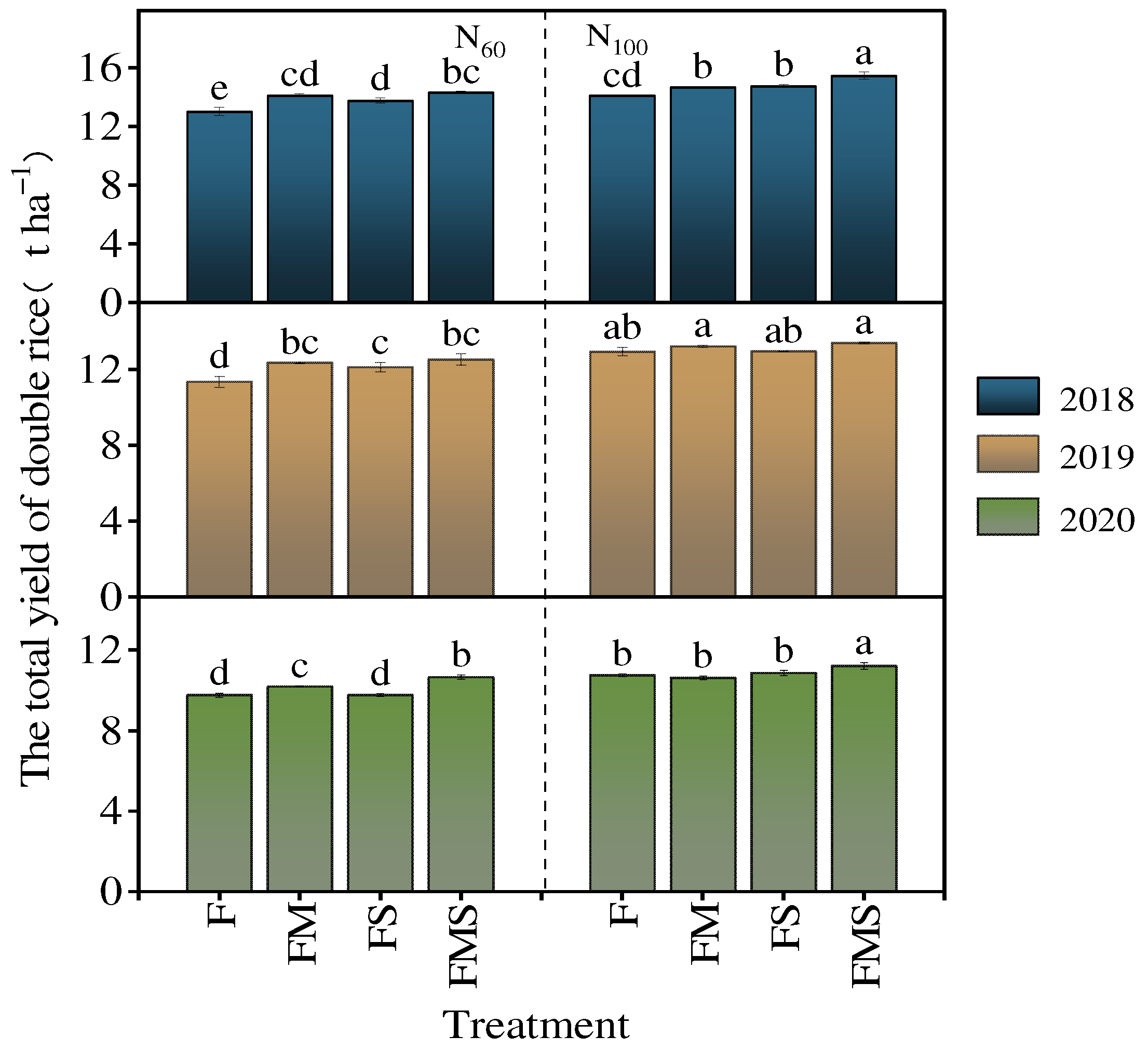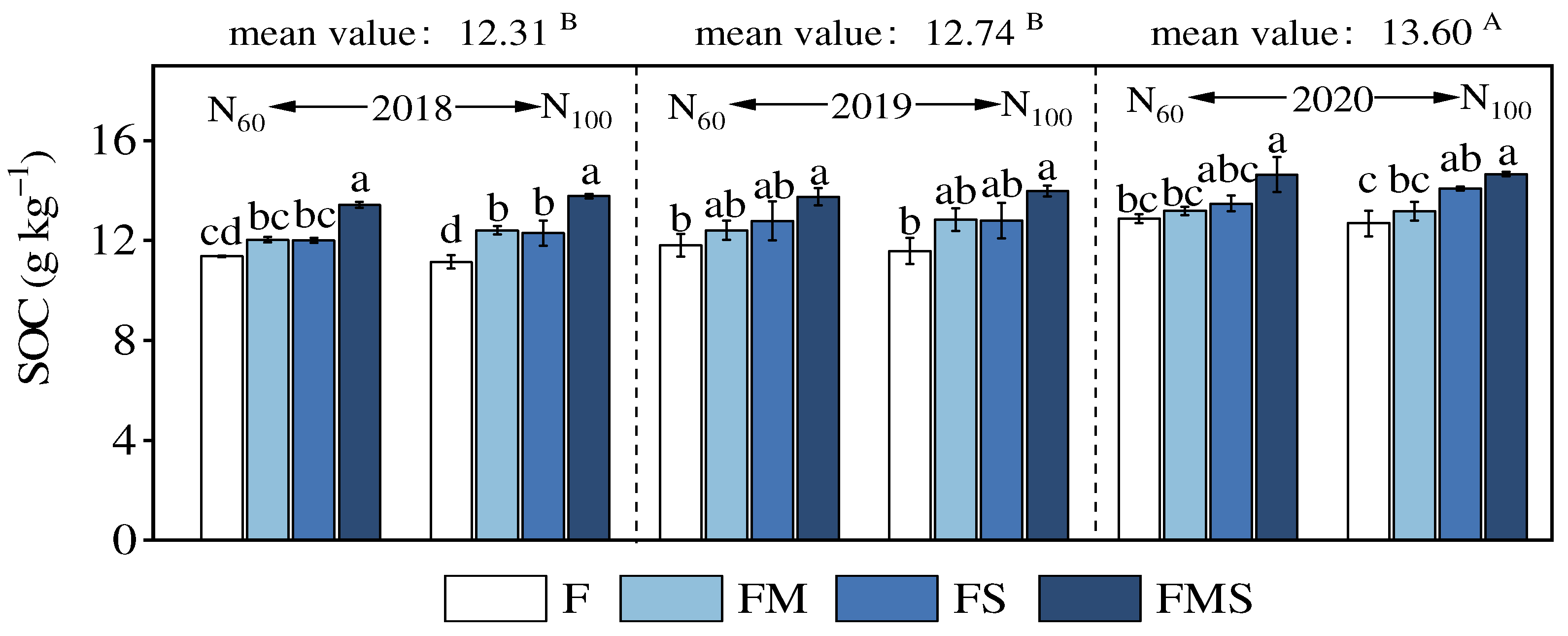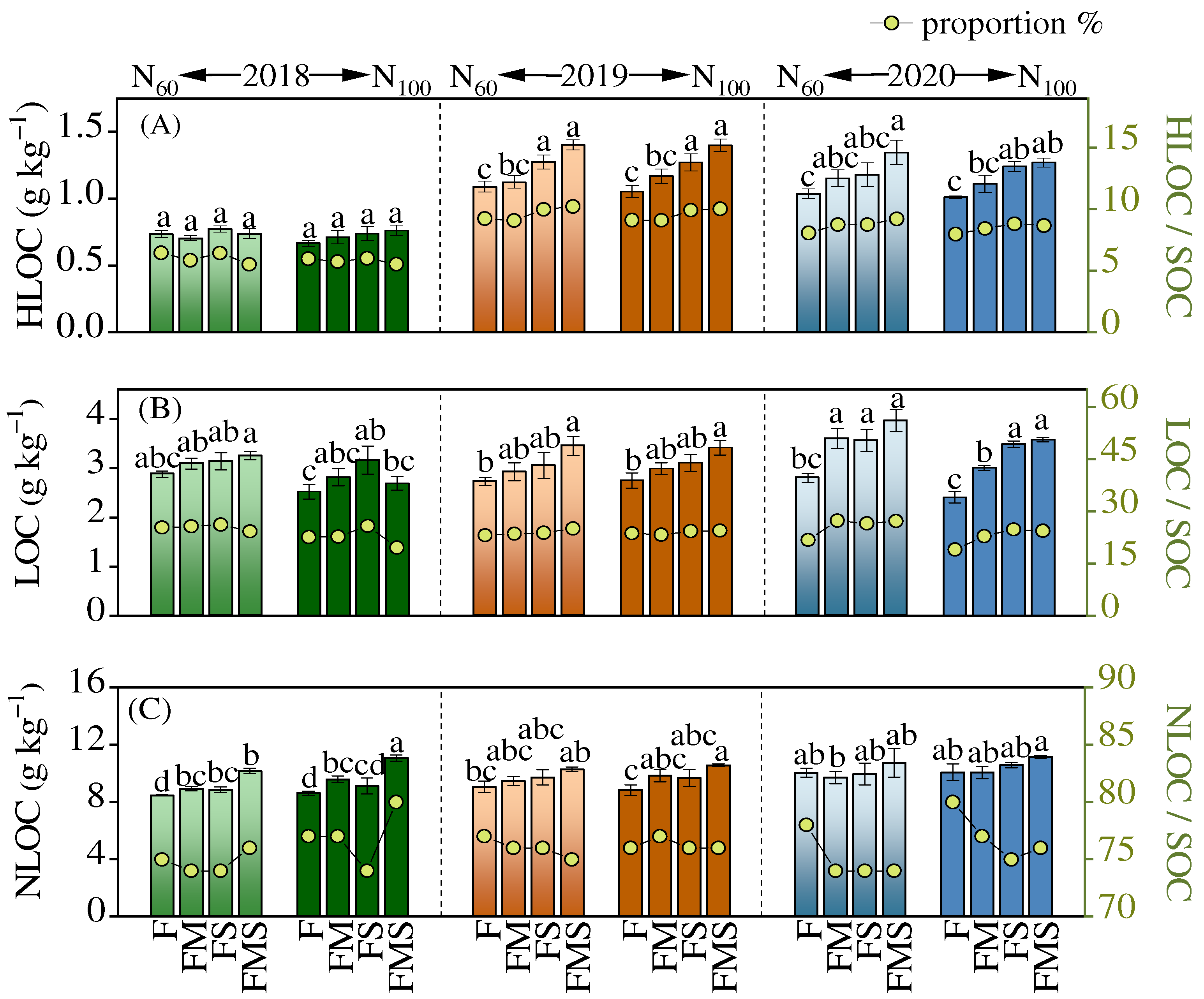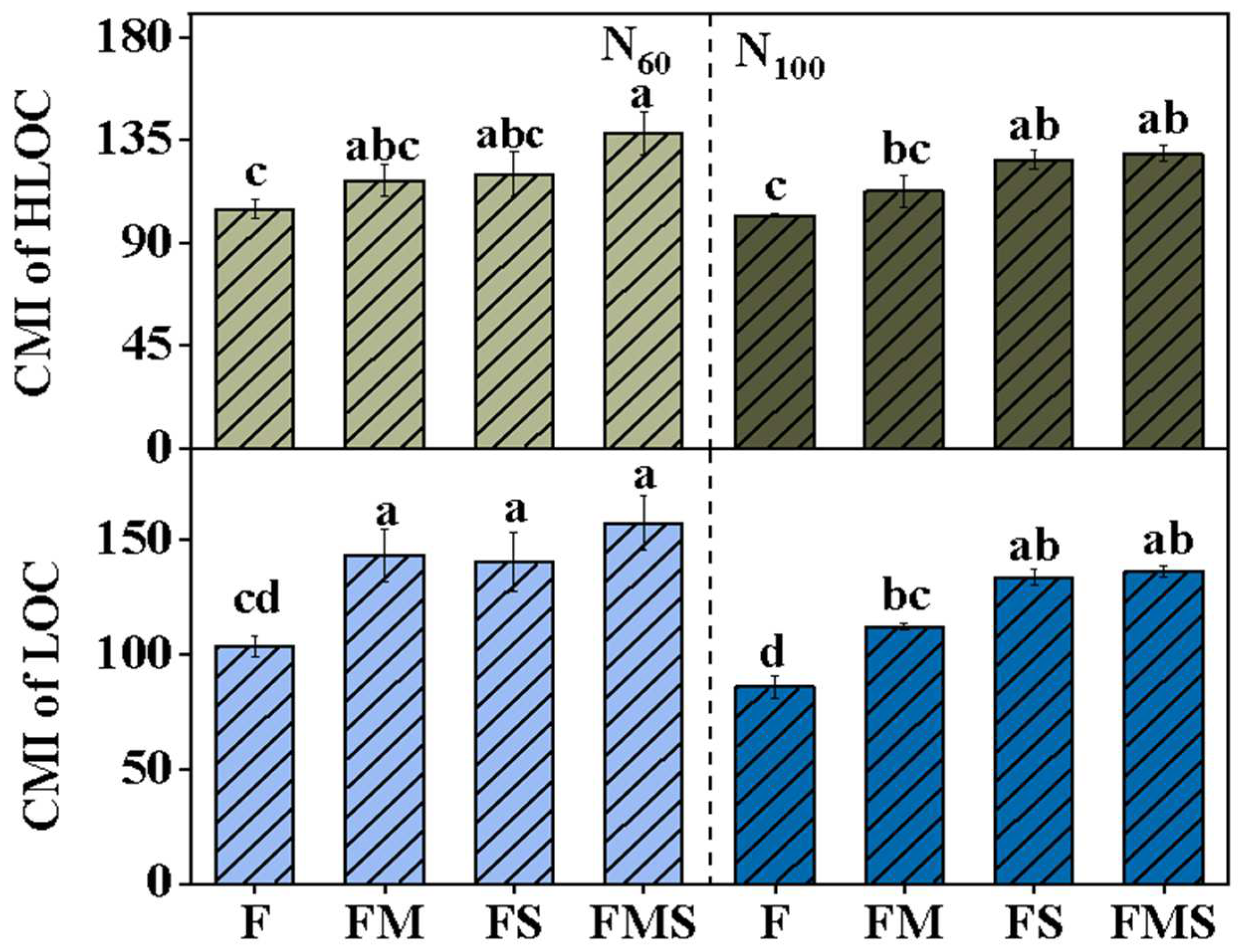Study on the Effects of Reducing Nitrogen Fertilizer: Stabilizing Yield and Carbon Sequestration by Synergistic Utilization of Chinese Milk Vetch and Rice Straw in Double-Cropping Rice Area
Abstract
:1. Introduction
2. Materials and Methods
2.1. Site Description and Experimental Design
2.2. C and N Input Estimation
2.3. Soil Sampling and Soil Analysis
2.4. Statistics Analysis
3. Results
3.1. Incorporation of Chinese Milk Vetch and Rice Straw Expanded or Maintained Rice Yield
3.2. Incorporation of Chinese Milk Vetch and Rice Straw Increased SOC Concentrations and Labile Organic C Fractions
3.3. Carbon Management Index
3.4. Incorporation of Chinese Milk Vetch and Rice Straw Affected C Sequestration Rates and C Stocks
3.5. The Relationship among C Input, N Input, Organic C/N, and Carbon
3.6. Effects of Key Factors on Yield and SOC
4. Discussion
4.1. Co-Incorporation of Chinese Milk Vetch and Rice Straw Increases the Rice Yield
4.2. Effects of Chinese Milk Vetch and Rice Straw on SOC and Its Labile Fractions
4.3. N Affects the Accumulation of SOC and Its Labile Fractions
5. Conclusions
Author Contributions
Funding
Data Availability Statement
Acknowledgments
Conflicts of Interest
References
- Shah, S.A.; Xu, M.; Abrar, M.; Mustafa, A.; Shi, W. Long-term fertilization affects functional soil organic carbon protection mechanisms in a profile of Chinese Loess Plateau soil. Chemosphere 2021, 267, 128897. [Google Scholar] [CrossRef] [PubMed]
- He, Y.; He, X.; Zhang, W.; Yang, X.; Huang, S. Long-term fertilization increases soil organic carbon and alters its chemical composition in three wheat-maize cropping sites across central and south China. Soil Tillage Res. 2018, 177, 79–87. [Google Scholar] [CrossRef]
- Li, T.; Gao, J.; Bai, L.; Wang, Y.; Huang, J.; Kumar, M.; Zeng, X. Influence of green manure and rice straw management on soil organic carbon, enzyme activities, and rice yield in red paddy soil. Soil Tillage Res. 2019, 195, 104428. [Google Scholar] [CrossRef]
- Bhardwaj, A.K.; Rajwar, D.; Mandal, U.K.; Ahamad, S.; Kaphaliya, B.; Minhas, P.S.; Prabhakar, M.; Banyal, R.; Singh, R.; Chaudhari, S.K.; et al. Impact of carbon inputs on soil carbon fractionation, sequestration and biological responses under major nutrient management practices for rice-wheat cropping systems. Sci. Rep. 2019, 9, 9114. [Google Scholar] [CrossRef]
- Gross, A.; Glaser, B. Meta-analysis on how manure application changes soil organic carbon storage. Sci. Rep. 2021, 11, 5516. [Google Scholar] [CrossRef] [PubMed]
- Kumar, K.A.; Swain, D.K.; Bhadoria, P. Split application of organic nutrient improved productivity, nutritional quality and economics of rice-chickpea cropping system in lateritic soil. Field Crops Res. 2018, 223, 125–136. [Google Scholar] [CrossRef]
- Liu, J.; Qiu, T.; Penuelas, J.; Sardans, J.; Tan, W.; Wei, X.; Cui, Y.; Cui, Q.; Wu, C.; Liu, L.; et al. Crop residue return sustains global soil ecological stoichiometry balance. Glob. Change Biol. 2023, 29, 2203–2226. [Google Scholar] [CrossRef] [PubMed]
- Zhou, G.; Gao, S.; Lu, Y.; Liao, Y.; Nie, J.; Cao, W. Co-incorporation of green manure and rice straw improves rice production, soil chemical, biochemical and microbiological properties in a typical paddy field in southern China. Soil Tillage Res. 2020, 197, 104–115. [Google Scholar] [CrossRef]
- Haynes, R. Labile organic matter fractions as central components of the quality of agricultural soils: An overview. Adv. Agron. 2005, 85, 221–268. [Google Scholar] [CrossRef]
- Liao, C.; Li, D.; Huang, L.; Yue, P.; Liu, F.; Tian, Q. Higher carbon sequestration potential and stability for deep soil compared to surface soil regardless of nitrogen addition in a subtropical forest. PeerJ 2020, 8, e9128. [Google Scholar] [CrossRef] [PubMed]
- Li, G.; Zhang, J.; Zhu, L.; Tian, H.; Shi, J.; Ren, X. Spatial variation and driving mechanism of soil organic carbon components in the alluvial/sedimentary zone of the Yellow River. J. Geogr. Sci. 2021, 31, 535–550. [Google Scholar] [CrossRef]
- Angers, D.; Arrouays, D.; Cardinael, R.; Chenu, C.; Corbeels, M.; Demenois, J.; Farrell, M.; Martin, M.; Minasny, B.; Recous, S.; et al. A well-established fact: Rapid mineralization of organic inputs is an important factor for soil carbon sequestration. Eur. J. Soil Sci. 2022, 73, e13242. [Google Scholar] [CrossRef]
- Guenet, B.; Juarez, S.; Bardoux, G.; Abbadie, L.; Chenu, C. Evidence that stable C is as vulnerable to priming effect as is more labile C in soil. Soil Biol. Biochem. 2012, 52, 43–48. [Google Scholar] [CrossRef]
- Liu, B.; Xia, H.; Jiang, C.; Riaz, M.; Yang, L.; Chen, Y.; Fan, X.; Xia, X. 14 year applications of chemical fertilizers and crop straw effects on soil labile organic carbon fractions, enzyme activities and microbial community in rice-wheat rotation of middle China. Sci. Total Environ. 2022, 841, 156608. [Google Scholar] [CrossRef] [PubMed]
- Xu, P.; Wu, J.; Wang, H.; Tang, S.; Cheng, W.; Li, M.; Bu, R.; Han, S.; Geng, M. Combined application of chemical fertilizer with green manure increased the stabilization of organic carbon in the organo-mineral complexes of paddy soil. Environ. Sci. Pollut. Res. 2023, 30, 2676–2684. [Google Scholar] [CrossRef] [PubMed]
- Pu, J.; Li, Z.; Tang, H.; Zhou, G.; Wei, C.; Dong, W.; Jin, Z.; He, T. Response of soil microbial communities and rice yield to nitrogen reduction with green manure application in karst paddy areas. Front. Microbiol. 2023, 13, 1070876. [Google Scholar] [CrossRef] [PubMed]
- Liu, Y.; Tang, H.; Smith, P.; Zhong, C.; Huang, G. Comparison of carbon footprint and net ecosystem carbon budget under organic material retention combined with reduced mineral fertilizer. Carbon Balance Manag. 2021, 16, 7. [Google Scholar] [CrossRef] [PubMed]
- Tang, H.; Liu, Y.; Li, J.; Miao, J.; Mawaz, M.; Ali, B.; Ali, S.; Aamer, M.; Hassan, M.; Huang, G. The effect of winter crop incorporation on greenhouse gas emissions from double rice-green manure rotation in South China. Environ. Sci. Pollut. Res. 2023. Online ahead of print. [Google Scholar] [CrossRef] [PubMed]
- Das, S.R.; Nayak, B.K.; Dey, S.; Sarkar, S.; Chatterjee, D.; Saha, S.; Sarkar, D.; Pradhan, A.; Saha, S.; Nayak, A.K. Potential soil organic carbon sequestration vis-a-vis methane emission in lowland rice agroecosystem. Environ. Monit. Assess. 2023, 195, 1099. [Google Scholar] [CrossRef] [PubMed]
- Ratnayake, R.R.; Perera, B.M.; Rajapaksha, R.P.; Ekanayake, E.M.; Kumara, R.K.; Gunaratne, H.M. Soil carbon sequestration and nutrient status of tropical rice based cropping systems: Rice-rice, rice-soya, rice-onion and rice-tobacco in Sri Lanka. Catena 2017, 150, 17–23. [Google Scholar] [CrossRef]
- IUSS Working Group WRB. World Reference Base for Soil Resources. In International Soil Classification System for Naming Soils and Creating Legends for Soil Maps, 4th ed.; International Union of Soil Sciences (IUSS): Vienna, Austria, 2022. [Google Scholar]
- Blair, G.; Lefroy, R.; Lisle, L. Soil carbon fractions based on their degree of oxidation, and the development of a carbon management index for agricultural systems. Aust. J. Agric. Res. 1995, 46, 1459–1466. [Google Scholar] [CrossRef]
- Li, J.; Wen, Y.; Li, X.; Li, Y.; Yang, X.; Lin, Z.; Song, Z.; Cooper, J.M.; Zhao, B. Soil labile organic carbon fractions and soil organic carbon stocks as affected by long-term organic and mineral fertilization regimes in the North China Plain. Soil Tillage Res. 2018, 175, 281–290. [Google Scholar] [CrossRef]
- West, T.O.; Post, W.M. Soil Organic Carbon Sequestration Rates by Tillage and Crop Rotation. Soil Sci. Soc. Am. J. 2002, 66, 1930–1946. [Google Scholar] [CrossRef]
- Gao, S.; Zhou, G.; Chang, D.; Liang, H.; Nie, J.; Liao, Y.; Lu, Y.; Xu, C.; Liu, J.; Wu, J.; et al. Southern China can produce more high-quality rice with less N by green manuring. Resour. Conserv. Recycl. 2023, 196, 107025. [Google Scholar] [CrossRef]
- Zhu, B.; Yi, L.; Hu, Y.; Zeng, Z.; Lin, C.; Tang, H.; Yang, G.; Xiao, X. Nitrogen release from incorporated 15N-labelled Chinese milk vetch (Astragalus sinicus L.) residue and its dynamics in a double rice cropping system. Plant Soil 2014, 374, 331–344. [Google Scholar] [CrossRef]
- Meng, X.; Li, Y.; Zhang, Y.; Yao, H. Green manure application improves rice growth and urea nitrogen use efficiency assessed using 15N labeling. Soil Sci. Plant Nutr. 2019, 65, 511–518. [Google Scholar] [CrossRef]
- Luo, M.; Liu, Y.; Li, J.; Gao, T.; Wu, S.; Wu, L.; Lai, X.; Xu, H.; Hu, H.; Ma, Y. Effects of Straw Returning and New Fertilizer Substitution on Rice Growth, Yield, and Soil Properties in the Chaohu Lake Region of China. Plants 2024, 13, 444. [Google Scholar] [CrossRef] [PubMed]
- Tosti, G.; Benincasa, P.; Farneselli, M.; Pace, R.; Tei, F.; Guiducci, M.; Thorup-Kristensen, K. Green manuring effect of pure and mixed barley–hairy vetch winter cover crops on maize and processing tomato N nutrition. Eur. J. Agron. 2012, 43, 136–146. [Google Scholar] [CrossRef]
- Liu, C.; Lu, M.; Cui, J.; Li, B.; Fang, C. Effects of straw carbon input on carbon dynamics in agricultural soils: A meta-analysis. Glob. Change Biol. 2014, 20, 1366–1381. [Google Scholar] [CrossRef] [PubMed]
- Wang, C.; Kuzyakov, Y. Rhizosphere engineering for soil carbon sequestration. Trends Plant Sci. 2023. Online ahead of print. [Google Scholar] [CrossRef]
- Zhao, S.; Li, K.; Zhou, W.; Qiu, S.; Huang, S.; He, P. Changes in soil microbial community, enzyme activities, and organic matter fractions under long-term straw return in north-central China. Agric. Ecosyst. Environ. 2016, 216, 82–88. [Google Scholar] [CrossRef]
- Zhou, G.; Chang, D.; Gao, S.; Liang, T.; Liu, R.; Cao, W. Co-incorporating leguminous green manure and rice straw drives the synergistic release of carbon and nitrogen, increases hydrolase activities, and changes the composition of main microbial groups. Biol. Fertil. Soils 2021, 57, 547–561. [Google Scholar] [CrossRef]
- Song, J.; Huang, J.; Gao, J.; Wang, Y.; Wu, C.; Bai, L.; Zeng, X. Effects of green manure planted in winter and straw returning on soil aggregates and organic matter functional groups in double cropping rice area. Ying Yong Sheng Tai Xue Bao 2021, 32, 564–570. [Google Scholar] [CrossRef] [PubMed]
- Powlson, D.S.; Bhogal, A.; Chambers, B.J.; Coleman, K.; Macdonald, A.J.; Goulding, K.W.T.; Whitmore, A.P. The potential to increase soil carbon stocks through reduced tillage or organic material additions in England and Wales: A case study. Agric. Ecosyst. Environ. 2012, 146, 23–33. [Google Scholar] [CrossRef]
- Chen, L.; Liu, L.; Qin, S.; Yang, G.; Fang, K.; Zhu, B.; Kuzyakov, Y.; Chen, P.; Xu, Y.; Yang, Y. Regulation of priming effect by soil organic matter stability over a broad geographic scale. Nat. Commun. 2019, 10, 5112. [Google Scholar] [CrossRef] [PubMed]
- Bai, T.; Wang, P.; Qiu, Y.; Zhang, Y.; Hu, S. Nitrogen availability mediates soil carbon cycling response to climate warming: A meta-analysis. Glob. Change Biol. 2023, 29, 2608–2626. [Google Scholar] [CrossRef] [PubMed]
- Lu, M.; Zhou, X.; Luo, Y.; Yang, Y.; Fang, C.; Chen, J.; Li, B. Minor stimulation of soil carbon storage by nitrogen addition: A meta-analysis. Agric. Ecosyst. Environ. 2011, 140, 234–244. [Google Scholar] [CrossRef]
- Zhang, Q.; Cheng, L.; Feng, J.; Mei, K.; Zeng, Q.; Zhu, B.; Chen, Y. Nitrogen addition stimulates priming effect in a subtropical forest soil. Soil Biol. Biochem. 2021, 160, 108339. [Google Scholar] [CrossRef]
- Liu, Y.; Zhang, J.; Li, Y.; He, P.; Dong, J. Do long-term N additions affect the soil organic carbon pool in temperate grasslands? Sci. Total Environ. 2022, 810, 152227. [Google Scholar] [CrossRef] [PubMed]









| N Level | -- | N60 | N100 | ||||||
|---|---|---|---|---|---|---|---|---|---|
| Treatment | -- | F | FM | FS | FMS | F | FM | FS | FMS |
| Dry biomass (t ha−1) | Crop residues | 3.32 | 3.46 | 3.31 | 3.59 | 3.67 | 3.63 | 3.72 | 3.86 |
| RS | -- | -- | 8.78 | 9.41 | -- | -- | 9.94 | 10.36 | |
| MV | -- | 1.48 | -- | 1.42 | -- | 1.38 | -- | 1.18 | |
| Dry biomass (t ha−1) | Crop residues | 1.51 | 1.58 | 1.51 | 1.64 | 1.67 | 1.66 | 1.7 | 1.76 |
| RS | -- | -- | 3.26 | 3.5 | -- | -- | 3.7 | 3.86 | |
| MV | -- | 0.59 | -- | 0.57 | -- | 0.55 | -- | 0.47 | |
| Total | 1.51 | 2.17 | 4.77 | 5.71 | 1.67 | 2.21 | 5.4 | 6.09 | |
| N input (Mg N ha−1) | Crop residues | 0.026 | 0.027 | 0.026 | 0.028 | 0.029 | 0.029 | 0.029 | 0.030 |
| RS | -- | -- | 0.054 | 0.058 | -- | -- | 0.061 | 0.064 | |
| MV | -- | 0.047 | -- | 0.045 | -- | 0.044 | -- | 0.037 | |
| CF | 0.198 | 0.198 | 0.198 | 0.198 | 0.33 | 0.33 | 0.33 | 0.33 | |
| Total | 0.224 | 0.272 | 0.278 | 0.329 | 0.359 | 0.403 | 0.42 | 0.461 | |
| C/N of organic addition | -- | 57.71 | 30.52 | 59.42 | 46.27 | 57.71 | 29.27 | 59.4 | 43.39 |
| p-Value | ||||
|---|---|---|---|---|
| Source of Variance | SOC | HLOC | NLOC | LOC |
| N Level | 0.394 | 0.517 | 0.024 (*) | 0.002 (**) |
| Treatment | <0.001 (***) | <0.001 (***) | <0.001 (***) | <0.001 (***) |
| Year | <0.001 (***) | <0.001 (***) | <0.001 (***) | <0.001 (***) |
| N Level × Treatment | 0.631 | 0.792 | 0.591 | 0.307 |
| N Level × Year | 0.965 | 0.896 | 0.472 | 0.045 (*) |
| Treatment × Year | 0.853 | 0.006 (**) | 0.120 | 0.007 (**) |
| N Level × Treatment × Year | 0.981 | 0.827 | 0.989 | 0.856 |
| N Level | Treatments | Bulk Density (g cm−3) | C Sequestration Rates (Mg C ha−1 yr−1) | C Stocks (Mg C ha−1) | ||
|---|---|---|---|---|---|---|
| SOC | NLOC | SOC | NLOC | |||
| N60 | F | 1.09 ± 0.03 abc | 0.84 ± 0.06 b | 0.77 ± 0.07 a | 21.05 ± 0.28 b | 16.46 ± 0.35 a |
| FM | 1.10 ± 0.01 ab | 0.98 ± 0.06 ab | 0.64 ± 0.12 a | 21.76 ± 0.28 ab | 15.81 ± 0.61 a | |
| FS | 1.05 ± 0.02 cd | 0.88 ± 0.10 b | 0.60 ± 0.17 a | 21.23 ± 0.50 b | 15.61 ± 0.85 a | |
| FMS | 1.04 ± 0.01 d | 1.20 ± 0.22 ab | 0.80 ± 0.23 a | 22.83 ± 1.08 ab | 16.64 ± 1.13 a | |
| N100 | F | 1.10 ± 0.02 a | 0.82 ± 0.17 b | 0.86 ± 0.17 a | 20.93 ± 0.84 b | 16.95 ± 0.86 a |
| FM | 1.09 ± 0.02 abc | 0.94 ± 0.12 ab | 0.80 ± 0.11 a | 21.53 ± 0.62 ab | 16.60 ± 0.56 a | |
| FS | 1.07 ± 0.02 abcd | 1.15 ± 0.03 ab | 0.87 ± 0.05 a | 22.59 ± 0.14 ab | 16.99 ± 0.23 a | |
| FMS | 1.06 ± 0.01 bcd | 1.29 ± 0.03 a | 1.00 ± 0.04 a | 23.30 ± 0.13 a | 17.64 ± 0.20 a | |
Disclaimer/Publisher’s Note: The statements, opinions and data contained in all publications are solely those of the individual author(s) and contributor(s) and not of MDPI and/or the editor(s). MDPI and/or the editor(s) disclaim responsibility for any injury to people or property resulting from any ideas, methods, instructions or products referred to in the content. |
© 2024 by the authors. Licensee MDPI, Basel, Switzerland. This article is an open access article distributed under the terms and conditions of the Creative Commons Attribution (CC BY) license (https://creativecommons.org/licenses/by/4.0/).
Share and Cite
Xie, X.; Liao, Y.; Lu, Y.; Zhang, J.; Li, P.; Tang, Y.; Cao, W.; Gao, Y.; Nie, J. Study on the Effects of Reducing Nitrogen Fertilizer: Stabilizing Yield and Carbon Sequestration by Synergistic Utilization of Chinese Milk Vetch and Rice Straw in Double-Cropping Rice Area. Agronomy 2024, 14, 675. https://doi.org/10.3390/agronomy14040675
Xie X, Liao Y, Lu Y, Zhang J, Li P, Tang Y, Cao W, Gao Y, Nie J. Study on the Effects of Reducing Nitrogen Fertilizer: Stabilizing Yield and Carbon Sequestration by Synergistic Utilization of Chinese Milk Vetch and Rice Straw in Double-Cropping Rice Area. Agronomy. 2024; 14(4):675. https://doi.org/10.3390/agronomy14040675
Chicago/Turabian StyleXie, Xue, Yulin Liao, Yanhong Lu, Jianglin Zhang, Peng Li, Youyun Tang, Weidong Cao, Yajie Gao, and Jun Nie. 2024. "Study on the Effects of Reducing Nitrogen Fertilizer: Stabilizing Yield and Carbon Sequestration by Synergistic Utilization of Chinese Milk Vetch and Rice Straw in Double-Cropping Rice Area" Agronomy 14, no. 4: 675. https://doi.org/10.3390/agronomy14040675
APA StyleXie, X., Liao, Y., Lu, Y., Zhang, J., Li, P., Tang, Y., Cao, W., Gao, Y., & Nie, J. (2024). Study on the Effects of Reducing Nitrogen Fertilizer: Stabilizing Yield and Carbon Sequestration by Synergistic Utilization of Chinese Milk Vetch and Rice Straw in Double-Cropping Rice Area. Agronomy, 14(4), 675. https://doi.org/10.3390/agronomy14040675






